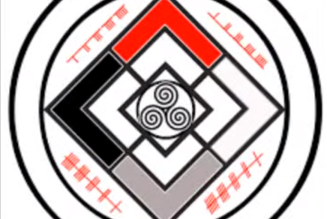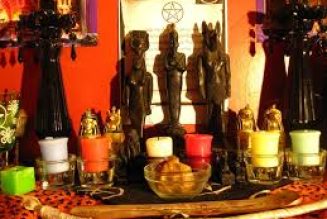
First, What is Norse Paganism?
Norse paganism is a type of modern paganism based on what we know about old Norse religion. When we say Norse, we are referring to the people who lived in Northern Europe who spoke the Old Norse language from ancient times through the Early Middle Ages. Now, you may hear Norse paganism isn’t a correct term, but it should be Norse neo-paganism, which means Norse “new” pagans. I don’t see a reason to sweat over labels in this way. Call yourself what you’d like.
A sort of misnomer that’s been perpetuated by modern popculture is calling Norse pagan beliefs the “Viking religion”. To clear up some misunderstandings, “Norse” doesn’t necessarily mean “Viking” and vice versa. A viking was actually a person who sailed the seas and often attacked or pillaged various destinations through Europe and the Middle East. The term Viking was actually akin to the word Pirate in the actual Viking Age. Yes, it is true that Norse people made up the bulk of what were “Vikings”, but the religion doesn’t originate with these seafarers. It comes from their lands of origin – various regions within Scandinavia. However, it is also true that the Vikings left their lands during the Viking Age to find new places to settles. Which also means they brought their religion with them.
Vikings were seafaring people from the Northern parts of Europe.
The Norse Pagan Pantheon: Realms of Spirits
The Norse people held an unique belief in the gods which was unlike many other ancient cultures of the time. Where the Romans and Greeks worshiped and “fell at the feet” of their gods, the Norse didn’t…necessarily. However, they did hold a deep respect and reverence for the gods and spirits.
They saw the gods as spirits that permeated nature, and they knew that they walked alongside these energies on a daily basis. Moreover, an ever-present underlying fear permeated life for many. Why? Because this was an age incredibly unlike our own. Advances in science and medicine did not exist, and the land and forces of nature were dangerous and unpredictable. The Norse people associated their environment with the gods. Therefore the gods and spirits could also be dangerous and unpredictable.
For instance, when the crop failed and people died, they didn’t know the scientific causes…they believed it was the spirits within the land that were angry with them. They were not un-intelligent. It was just a different time. So we have to keep that in mind when we read the Sagas and Eddas and learn of some of the “barbaric” acts performed. And consider, if you lived then and had a god that is angry and seems to be punishing you, you’ll do anything to regain that god’s favor and save yourself and your family, right?
Many Kinds of Spirits
The Norse pagan pantheon consists of multiple types of spirits. The spirits attached to place and family include the Landvaettir, Disir, and Alfar. Then we have the the two classes of gods, the Vanir (an Elven race of earthly gods) and the Aesir (the sky gods). In addition, there are giants known as the Jotunn and dwarves called Dvergr. And, as we travel up and down Yggdrasil the Norse World Tree, we meet even more spirits and entities like The Norns who control the fate of the gods. And monsters like Níðhǫggr, a worm that gnaws at the roots of Yggdrasil. If you make it to the realm of the goddess Hel known as Helheim (or Niflheim in some legends), you’d also meet the souls of the dead.
Some of the major deities Norse pagans frequently honor in their practice include Odin, Thor, Freyr, Freya, Frigg, Heimdall, and Baldr. There are also Norse pagans who work with the Jotunn and gods like Loki, Hel, and Angrboda. Honoring and working with one’s ancestors is important including one’s Disir (female ancestors) and Alfar (male). As well as working with the landvaettir (land spirits) that are local to your area. Whether you actively invoke the Norse pagan gods and spirits or simply study them is entirely up to you!
Perhaps one of the most significant ancient Norse pagan sites is located in Uppsala, Sweden. The modern city once housed a Temple that is believed to have once been a major pagan site attested in Sturluson’s Sagas and Adam of Bremen’s historical treatise from the 11th century AD. At Uppsala, there were statues of three major gods sitting on a triple throne, according to Adam of Bremen’s work. Thor, Odin, and Freyr. People came from all over to pray and sacrifice to these gods. That being said, there are scholars and archaeologists who dispute Adam’s claims that the Temple at Uppsala was ever pagan to begin with. But actually Christian but were resisting the Sacred Roman Empire and therefore painted in a “evil” pagan guise.
What we know for sure from Uppsala archaeological digs, as well as others, is that Norse pagans were fond of feasting together which likely included the sacrifical “blot” or the pouring out of blood in honor of the gods. This could have included the sacrificial boar at Yule, which has carried over in modern tradition in the form of the Christmas ham. Archaeological evidence shows great pagan halls or “feasting halls” at ancient and Viking age sites throughout Norway, Sweden, and Denmark.
Other Pagan Temples and Burial Mounds
According to ArchEurope, “The remains of a pagan temple have been excavated at Ose, Ørsta, Norway. The building was about 14 meters long, 8 m wide, and up to 12 m high. It is thought to date from the end of the eighth century. ‘This is the first Old Norse temple found in Norway’, said archaeologist Søren Diinhoff of the University Museum of Bergen. ‘We know them from Sweden and we know them from Denmark. … This shows that they also existed in Norway.’ He said. ‘This is probably something to do with a certain class of the society, who built these as a real ideological show.”
Runestones and burial mounds are common archaeological marvels throughout Northern Europe that give us a glimpse into the past. We can glean some understanding of the Norse peoples from these stones, mounds, and remains. But truly our ultimate resource and look into old Norse paganism is through the Eddas and Sagas written by Snorri Sturluson in the twelfth century AD.
Stone circles and burial mounds tell us a bit about Norse paganism of the past.
Ways to Learn and Practice Norse Paganism Today
There’s something to be said about pagan religions and practices that are on the rise today. Quite a lot to be said, actually. What we recommend is to study and practice on your own before joining a group or church or coven. The reason is this – some of these Norse pagan groups and organizations may seem to have your best interest in mind, but they turn out to be deviant, racist, and some might even have cult-like tendencies. Please be careful and follow your intuition/gut above all else. For now, here’s what we recommend when diving into Norse paganism today on your own accord:
1. Read the Eddas and Sagas
I have found the most fulfilling means of learning about Norse paganism is to study the Norse Eddas and Sagas. Don’t rush this process. Take one legend at a time, read it slowly, try to absorb the material. Take notes. And then research different interpretations to get a thorough understanding. Other helpful modern resources include The Viking Spirit by David McCoy, Norse Mythology by Neil Gaiman, and The Lore of Old Elfland by Linda Raedisch.
2. Form Your Own Opinion
The great thing about being a pagan is that you can form your own opinion, beliefs, and practice. There is no pope, no pastor, no reverend. I’m sure if you join a coven or group, there might be a leader or priest/priestess, but again…be careful with these groups. Form your own personal gnosis first.
3. Altars for the Gods
I always say, if you’re actively seeking to work with the gods, altars are helpful in starting those relationships. And making those divine connections. We know many of the old pagan altars were outside. So if you’re can erect an altar outside for any of the Norse pagan gods, that is perfect! But if you don’t have access to an outside area, inside altars are common practice too. If you don’t know how to build an altar, we detail the process here.
4. Explore Belief in Disir, Landvaettir, Etc.
There are many spirits in Norse paganism. The gods are only a few. Explore the stories and your own personal beliefs in the Disir, Alfar, and Landvaettir. The Disir are protective maternal ancestors who also control our fate. The Alfar are also ancestors but in a deified form. And the landvaettir are spirits of the land on which we reside.
5. Celebrate/Honor the Norse Holidays
In modern pagan/Wiccan practice, there is a series of seasonal holidays that span the entire year. This model is called the Wheel of the Year. There are three sabbats on the Wheel of the Year that are inherently or Norse/Germanic origin including Ostara (Spring Equinox), Litha (Summer Solstice), and Yule (Winter Solstice). In addition to these three sabbats, there are more Norse Germanic holidays and festivals to observe. Including Disablot, Alfablot, Walpurgisnacht, Winter Nights, Krampusnacht, Modraniht, Disting, Wife’s Day and Husband’s Day. There are many others.
6. Connect with Norse Ancestors
If you’re unsure as to what gods or deities you’d like to work with in the Norse pagan pantheon, at the very least reach out to your Norse and Northern European ancestors. You don’t have to view them in the light of Disir or Alfar, just simply your ancestors. Learn how to connect with ancestors here.
7. Take up the Runes
Not every Norse pagan works with the runes. The process of connecting with, understanding, and bonding with the runes is a lifelong pursuit. It is not one to take lightly, and so I don’t recommend it unless you feel you are being called. Think of it like this – not every god in the Norse mythos had access to and used the runes. Odin himself hung from Yggdrasil for nine days with no food and no water in order to be gifted sight of the runes. It is a journey, not a trend or hobby. If you do feel called, start learning the basics of the Elder Futhark here.
8. Go On a Norse Pagan Pilgrimage
If you have the ability, take a Norse pagan pilgrimage to the lands of your ancestors. Norway, Iceland, Denmark, Sweden and Germany. Even England is appropriate. Why is England appropriate? Because the Angles and Saxons originally came from Germanic lands.
9. Consider Practicing Seidr
Seidr is a Norse magical practice from ancient times that involves sorcery, shapeshifting, and prophesying. The practitioners of this craft were known by different names depending on the region and people including Volva, Seidrkona, and Hellerune. If you lean towards the witchcraft aspect of paganism, consider studying Seidr if you feel drawn to do so.






